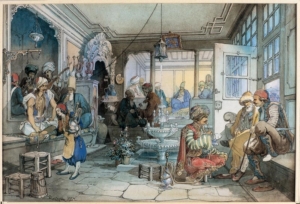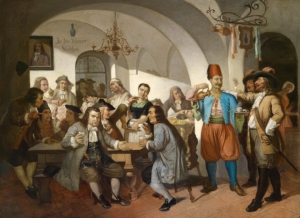Coffee on my Mind
May 20, 2014
A couple of nights ago, a chance (re)encounter with Kristof Glaman’s classic study of the Dutch East India Company, Dutch-Asiatic Trade (1981), led me to this wonderful primary source on the history of the introduction of the cafe and of the coffee beverage in Paris by Jean de La Roque published in 1716 in French. Thanks to the wonders of google books, I downloded the work and found a detailed and fascinating, even if anectotal, history of how Levantines, (Armenians, Greeks, Jews, and Maronites) played an important role as go-betweens in introducing that quintessential Middle Eastern institution, the coffeehouse, to the streets of Paris. Below is a transcription and quick translation into English of the juicy passages for those who have the patience and are interested. Forgive the typos and other mistakes.
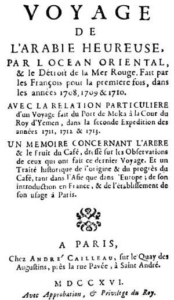 Jean de La Roque, Voyage de L’Arabie Heureuse, par l’ocean oriental, & le détrois de la Mer Rouge. Fait par les François pour la premiere foi, dans les annés 1708, 1709, & 1710 Avec [….] un memoire concernant l’arbre & le fruit du Café, dressé sur les Observations de ceux qui ont fait ce dernier Voyage. Et un Traité historique de l’origine & du progrès du Café, tant dans l’Asie que dans l’Europe, de son introduction en France, & de l’établissement de son usage à Paris. (Paris: 1716)
Jean de La Roque, Voyage de L’Arabie Heureuse, par l’ocean oriental, & le détrois de la Mer Rouge. Fait par les François pour la premiere foi, dans les annés 1708, 1709, & 1710 Avec [….] un memoire concernant l’arbre & le fruit du Café, dressé sur les Observations de ceux qui ont fait ce dernier Voyage. Et un Traité historique de l’origine & du progrès du Café, tant dans l’Asie que dans l’Europe, de son introduction en France, & de l’établissement de son usage à Paris. (Paris: 1716)
“Avant l’année 1669, on n’avoit point vû de café à Paris, & l’on n’en avoit presque entendu parler que chez Monsieur Thevenot, & dans les Relations des voyageurs; mais cette année là, distinguée dans nôtre histoire par l’Ambassade solemnelle de Soliman Aga, qui fut envoyé au Roy par le Sultan Mehemet IV, doit passer pour la veritable époque de la premiere introduction du café à Paris; car cet Ambassadeur & les gens de sa suite y apporteren beaucoup de café, & ils en presenterent à tant de personnes de la Cour & de la Ville, qui rendoient visite par curiosité au Ministre Turc, comme l’on fait actuellement à l’égard de l’Ambassadeur de Perse, que bien des gens s’y accoutumerent enfin, en y mettant du sucre & d’autre à qui le café faisoit du bien, ne purent presque plus s’en passer.
[…]
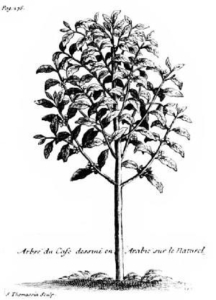 Après le départ de l’Ambassadeur, cet usage fut continué par plusieurs personnes, qui trouverent moyen d’avoir du café, en le faisant venir de Marseille ou d’ailleurs. Enfin on vit arriver en cette ville le nommé Pascal, Armenien de Nation, lequel en l’année 1672, s’avisa de debiter du café publiquement, à la foire Saint Germain, ensuite il se fixa dans une petite boutique sur le Quai de l’Ecole, où il donnoit le café pour deux sols six deniers la tasse; mais on ne gueres chez luy que quelque Chevaliers de Malte, & des Etrangers, en force que cet Armenien fut obligé de quitter, & de se retirer à Londres.
Après le départ de l’Ambassadeur, cet usage fut continué par plusieurs personnes, qui trouverent moyen d’avoir du café, en le faisant venir de Marseille ou d’ailleurs. Enfin on vit arriver en cette ville le nommé Pascal, Armenien de Nation, lequel en l’année 1672, s’avisa de debiter du café publiquement, à la foire Saint Germain, ensuite il se fixa dans une petite boutique sur le Quai de l’Ecole, où il donnoit le café pour deux sols six deniers la tasse; mais on ne gueres chez luy que quelque Chevaliers de Malte, & des Etrangers, en force que cet Armenien fut obligé de quitter, & de se retirer à Londres.
Trois ou quatre année après, Maliban, autre Armenien, vint aussi à Paris dans le méme dessein; il ouvrit son Café dans la rue de Bussy, près le jeu de paulme de Mets, aux environs de l’Abbaye Saint Germain. Il donnoit aussi à fumer, & vendoit le café au même prix. il passa de là dans la rue Feron, près Saint Suplice, d’où il revint encore dans sa premiere demeure de la rue de Bussy; mais il n’y fit pas un long sejour, parce qu’il fut obligé d’aller en Hollande, après avoir établi dans la même boutique, le nommé Gregoire son garçon, ou son associé, lequel estoit venu d’Ispaham avec d’autres Armeniens.
Ce Gregoire passa ensuite dans la rue Mazarine, pour profiter du voisinage de la Comedie, qui se jouoit alors dans la même rue, vis-à-vis de celle de Guenegaud, & il s’établit dans le même lieu, qui est aujourd’hui occupé par la veuve Gantois; ce ne fut pas pour longtemps, car la Comedie changeant de lieu, il vint se loger dans la rue, & du même côté où elle se joue aujourd’hui & de là il passa dans la maison qu’il a depuis acquise, & où il est enfin mort fort âgé l’année derniere. Quand Gregoire quitta la rue Mazarine, il eut pour successor dans la même lieu, le nommé Makara, Persan de Nation, lequel aprés avoir exercé pendant quelque temps la même profession, s’en retourna en Perse laissant son Café a un Liegeois nommé le Gantois.

Philippe de Champaigne,Portrait of Jean de Thévenot, ca.1660. Oil on canvas, 59.7 x 43.2 cm, The Huntington Library, Art Collections, and Botanical Gardens. Purchased with funds from the Art Collectors’ Council and the BrowningMemorial Art Fund, Object Number: 2010.2
Dans ces premiers temps, un petit boiteux, nommé le Candiot, aloit par les rues de Paris, en eriant du café; & ceux qui en vouloient prendre le faisoient monter chez eux, où il leur remplissoit un gobelet de la maison ou un des siens pour deux sols, en fournissant aussi le sucre. Il étoit ceint d’une serviette fort propre, portant d’une main un réchaut fait expès, sur lequel estoit une cafetiere, & de l’autre une espece de fontaine remplie d’eau, & devant lui un inventaire de fer blanc où estoient toutes les utensiles du café.
Ce Candiot eut pour compagnon dans la même métier de porter du café par la ville, le nommé Joseph, qui estoit aussi venu du Levant pour chercher fortune à Paris, par le moyen du café. Après avoir vendu en plusiers endroits fixes, il est enfin mort fort accomodé dans sa maison au bas du Pont Nôtre-Dame, que sa veuve tient encore aujourd’ui.
Enfin Estienne originaire d’Alep., vint aussi à Paris dans le même desein, mais posterieurement à tous ces gens là. Après de foibles commencemens, il a longtemps tenu son Café sur le Pont au Change, & enfin il s’est fixé dans la maison qu’il occupe aujourd’hui rue Saint André, dont la boutique l’une des plus grandes, & des plus commodes de la ville, est, en face du Pont Saint Michel.
Ce Sont là les premiers introducteurs des Cafés publics dans Paris. Ils furent imités par plusieurs autres Levantins, qui dans la suite n’ont pas peu profité dans la même profession. Je dis dans las suite, car les premiers commencemens de tous ces gens-là ont esté foibles. Les honêtes gens euresnt d’abord de la peinne à se resoudre d’entrer dans ces sortes de cabarets, où l’on fumoit, & où l’on vendoit de la biere, sans compter que le café n’y estoit pas exquis, & trop proprement servi.
Enfin cet usage de prendre du café en de semblable lieux, & en grande compagnie, s’est si bien fortifié à Paris, & il a esté trouvé si propre à former des societez agreable, que peu à peu ces lieux, ou maisons de Cafés, ont estés multipliez jusqu’au nombre d’environ trois cens à quoi je trouve qu’ils font à peu près fixés aujourd’hui…..”

La Magnifique Audiance donnée le 5 Décembre 1669 à S. Germain en Layepar le Roy très chrestien à Soliman Aga Musta-Feraga, envoyé du grand seigneur, print. Bibliothèque Nationale de France, département Estampes et photographie.
Before the year 1669, coffee had not been seen at all in Paris, and it had scarcely been heard of only at the house of Monsieur Thevenot and in the account of the voyagers. However, that very year (1669), distinguished in our history by the solemn embassy of Soliman Aga, who was sent to the king (Louis XIV) by Sultan Mehmet IV, must figure as the true epoch of the first introduction of Coffee in Paris. The reason for this is that this ambassador and the men in his entourage brought much coffee there (Paris) and offered some to so many persons of the (royal) court and of the city who had paid a visit to the Turkish minister out of curiosity as they do presently to the Persian ambassador, that a good number of people became finally accustomed to it (coffee), by adding sugar to it, and others to whom coffee did some good, could hardly ever do without it.
[…]
After the departure of the ambassador, several persons, who had found a means of acquiring coffee by having it brought from Marseille or elsewhere, continued this custom. Finally there arrived in this city someone named Pascal, Armenian by nation, who in the year 1672, took upon himself to publicly sell coffee at the fair of Saint Germain. Afterwards, he established himself in a small stall on the Quai l’Ecole, where he offered coffee for two sols and six deniers per cup. But his place was hardly frequented by anyone but a few members of the Nights of Malta and some foreigners to the point that this Armenian was obliged to quit and to retreat to London.
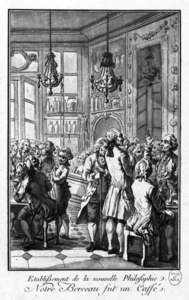 Three or four years later another Armenian, Maliban, also came to Paris with the same purpose; he opened his café on Rue de Bussy close to the tennis courts of Mets, in the vicinity of Abbaye Saint Germain. He also provided tobacco to smoke and sold coffee at the same price [as his predecessor].
Three or four years later another Armenian, Maliban, also came to Paris with the same purpose; he opened his café on Rue de Bussy close to the tennis courts of Mets, in the vicinity of Abbaye Saint Germain. He also provided tobacco to smoke and sold coffee at the same price [as his predecessor].
From there he moved to the Rue Feron, near Saint Suplice, whence he returned again to his first residence of the rue de Bussy; but he did not stay there long because he was obliged to go to Holland after having established in the same shop, his son named Gregoire, or his partner, who had come from Isfahan with other Armenians.
This Gregoire then moved to the Rue Mazarine in order to take advantage of being next to the Comedie [Francaise] which was then played on the same street vis à vis to that of Guenegaud, and he set himself up in the same spot which is today occupied by the widow of the one from Ghent. The was not to be for long, for the Comedy changing its place, he [Gregoire] came to stay on the street on the same side where the Comedy plays today and from there he moved into a house he has since acquired and where he finally died last year very old.
When Gregoire quit the Rue Mazarine, he had as a successor in the same place a man named Ma[r]kara, Persian by nation, who, after having conducted the same profession for some time, returned to Persia leaving his Cafe to a man from Liege named Gantois.
During those early times, a small lame person named Candiot used to go through the streets of Paris, shouting “Café”; and those who wanted to drink some would make him come up to their residences, where he would fill the coffee for them into a goblet from their homes or into one of his own for two sols, supplying also the sugar. He would be wearing a very clean towel purposefully carrying in one hand a camping stove on which was a coffee pot, and in the other hand a sort of bucket filled with water and in front of it a white tinplate where all the utensils of coffee were placed.
This Candiot had as a companion in the same profession of coffee porter throughout the city, a man named Joseph who had also come from the Levant to seek his fortunes in Paris by means of coffee. After having sold it in several fixed places, he finally passed away very well settled into his house at the foot of the Nôtre-Dame bridge, that his widow still holds today.
Lastly, Etienne originally from Aleppo came to Paris with the same purpose but well after all the above said men. After some humble beginnings he kept his cafe on the Change bridge, and he at last, settled in the house which he occupies today on Rue Saint André, whose shop is one of the biggest and most comfortable in the city and is across from the bridge Saint Michel.
These are the first introducers of public Cafés in Paris. Other Levantines, who afterwards did not profit little in the same profession, copied them. I say afterwards because the first beginnings of all these above said people were humble.
The honest people at first had some difficulties in deciding to getting into these kinds of cabarets where people smoked and where they sold beer, not taking into account that the coffee was not exquisite and properly served.
At last this custom of having coffee in similar places and in large company has been so well fortified in Paris and it has been found to be so proper in forming pleasant societies, that little by little these places or coffeehouses have multiplied up to the number of around three hundred at which they still are fixed more or less today …

